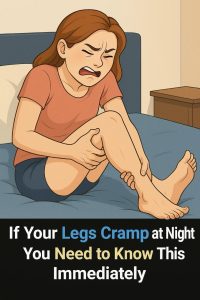
Night leg cramps are sudden, painful muscle contractions that often strike in the middle of the night, leaving many older adults, pregnant women, athletes, and even sedentary individuals struggling to sleep. These involuntary spasms are usually linked to a combination of muscle fatigue, poor circulation, and mineral imbalances involving magnesium, potassium, and calcium, all essential for proper muscle function.
Seniors are particularly vulnerable due to reduced muscle elasticity, changes in nerve signaling, and decreased blood flow to the legs, making nighttime cramps more frequent and intense. Pregnant women often experience them in the second and third trimesters because of added weight, hormonal shifts, and altered circulation.
Athletes or highly active individuals may also suffer from cramps after strenuous workouts that deplete electrolytes and fatigue muscles, while sedentary people face risks from prolonged periods of sitting or standing, which restrict circulation. Underlying health conditions such as diabetes, peripheral artery disease, kidney issues, thyroid disorders, or neurological problems can further increase the likelihood of cramps, as can certain medications like diuretics, statins, and some asthma or birth control drugs.
Practical strategies to reduce nighttime cramps include staying hydrated, stretching calves, hamstrings, and feet before bed, maintaining healthy mineral intake, staying active to improve circulation, and adjusting sleep positions. While occasional cramps are normal, frequent or severe episodes, especially those accompanied by swelling or skin changes, should be evaluated by a healthcare professional to rule out serious conditions and receive targeted treatment. With awareness and simple preventive measures, night cramps can often be minimized, allowing for more restful and pain-free sleep.